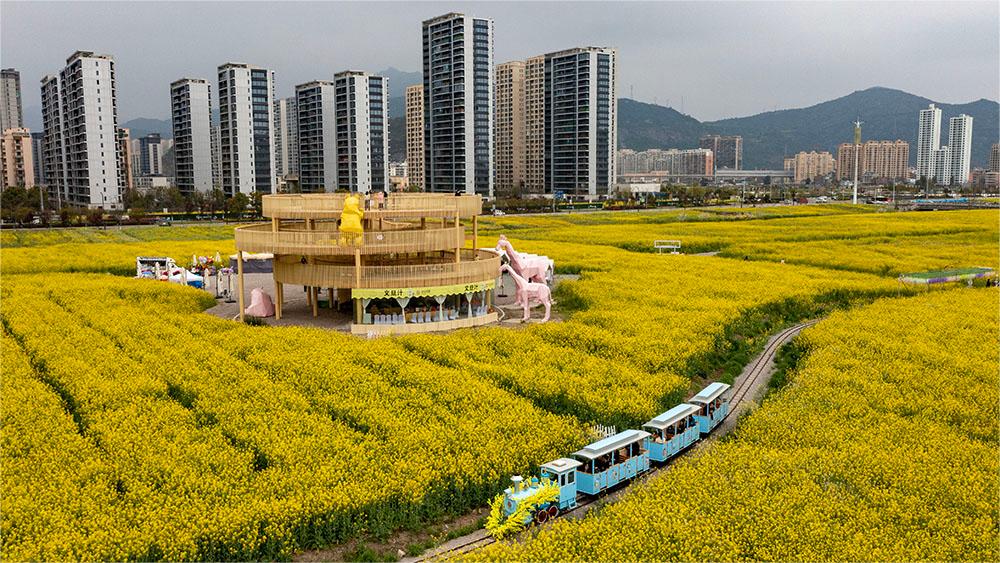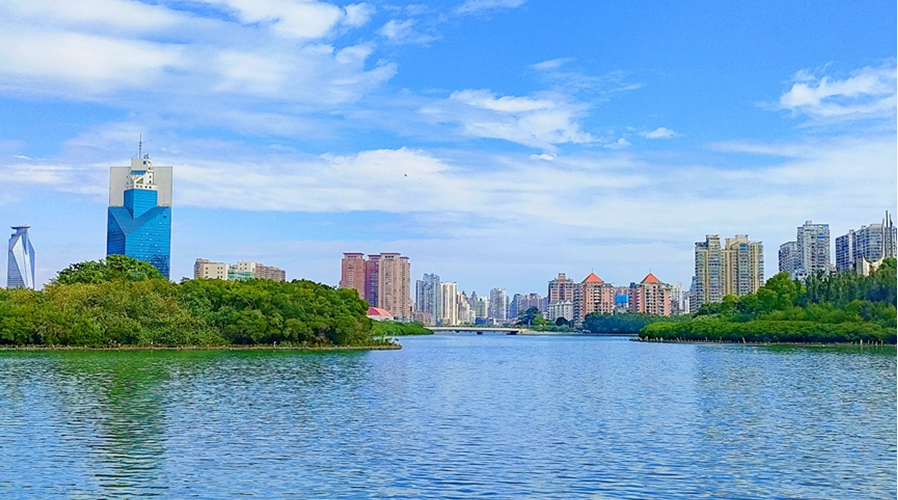China's rice technology nourishing Africa's needs

Perennial rice Yunda 107 is harvested from a test field in Luwero, Uganda. WU XIAOHUI/CHINA DAILY
In China's vast rice breeding community, Hu Fengyi is in the minority.
Over the past two decades, the plant scientist at Yunnan University has maintained a sharp focus on mining the potential of a perennial rice variety originally from Africa, which can be harvested multiple times and reduces labor costs.
Unlike hybrid rice and other conventional high-yield varieties, perennial rice has received limited academic attention in the past.
"There are lots of researchers studying rice in China, and if your research is mainstream you are able to compare notes with your fellow researchers," he said.
However, perennial rice is such a little-researched field that it is impossible to work with others to fast-track progress. "You have to feel the way forward in the darkness," Hu said.
Through trial and error, Hu and his colleagues have combined the perennial variety with mainstream ones, and rolled out three hybrid varieties that can transcend rice's normal life cycle, and when grown in the right environment provide stable yields.
Compared with hundreds of new rice varieties approved for commercial production across the country each year, the three hybrid ones approved for commercial production after decades of research are a telltale sign of the solitary nature of rice scientists' work. "To make it, we had to sit on a cold bench," Hu said, using a Chinese saying that describes someone being left out. "We've learned to withstand solitude."
Two of Hu's hybrids were named after the college he works at — Yunda 107 and Yunda 25.Over a three-year trial period, Yunda 25 produced 5.5 to 6.5 metric tons annually per hectare and showed outstanding resistance to pests, which greatly reduced the need for pesticides.
"It is not unlike rolling out new car models," Hu said, referring to the enhanced traits of newer perennial varieties. "You can add functions to newer models and can improve existing ones."
Apart from reducing labor, Hu said perennial rice is also more ecologically friendly as farmers do not have to plant every year. "The soil conditions are less disturbed physically as well as chemically," he said.
Perennial rice's popularity has grown quickly in China and among its rice-producing neighbors. In 2020, less than 4,000 hectares of perennial varieties were planted, but a year later the number ballooned to more than 15,500 hectares.
The expansion of perennial rice is also representative of China's shift to a more tech-driven approach to improve agricultural productivity and ensure the security of staple food supplies.
Honoring promises
As part of its commitment to help Africa improve the continent's food security, China has started to share its perennial rice technology, a move which has been hailed by both agricultural experts and farmers.
The technology was incorporated into the agricultural technology advancement framework at the High-Level Ministerial Session of the fifth African Union Specialized Technical Committee on Agriculture, Rural Development, Water, and Environment held in November last year.
It has also been included in the African Union Seeds and Biotechnology Program 2024-2025, and has already been introduced in Uganda, Malawi, Madagascar and Burundi, through collaborations between Chinese and African agricultural experts.
Luo Tingyue, a Chinese technician for the FAO-China-Uganda South-South Cooperation (Phase 3) program who has been promoting rice-planting technologies in Uganda for five years, said he and his colleagues started to grow perennial rice in September.
The rice, which is planted at the China-Uganda Agricultural Cooperation Industrial Park in Lubenge wetland in Uganda's Luwero district, was harvested last month.
Noting that perennial rice can be harvested several times after planting, he said it saves a great deal in labor costs and farmers' time, making it a superior species for use in African countries.
In addition, perennial rice has also demonstrated higher yields compared with many conventionally grown species in Uganda, Luo said. It produced 1.5 to 2.5 metric tons per 4,050 square meters in trial production, compared with around 1 ton for conventional rice, he said.
"The grain looks longer and bigger," Luo said, holding a handful of rice. "According to our measurements, every 1,000 grains of the rice weighs 29 grams, compared to between 23 and 26 grams for every 1,000 grains of locally planted rice species."

Ugandan farmers harvest perennial rice from a test plot in Luwero, Uganda on Jan 27. WU XIAOHUI/CHINA DAILY
Sowing knowledge
To ensure good rice yields, Luo and his colleagues have been teaching rice-planting techniques to local farmers in recent years — including how to plant seedlings and how to use fertilizers and pesticides. However, the educational process has had to overcome hurdles.
For instance, in China, farmers usually plant the lower part of rice seedlings in the paddy field's water in order to promote the growth of the roots. However, many farmers in Luwero plant rice seedlings much deeper in the water.
"We are also cooperating with local agriculture departments to jointly train rice farmers here, hoping that they will learn advanced planting techniques to improve rice yields," Luo said.
Jimmy Lamo, the cereals program leader at Uganda's National Crops Resources Research Institute, said perennial rice has already been planted in several irrigation areas of the country.
The perennial rice variety has grains that are similar to the popular local variety called Super, which is aromatic and soft when cooked. Local people have started calling the perennial variety "New Super", Lamo said.
Perennial rice doesn't require a lot of water and when it's grown in upland areas that receive a lot of rain, farmers get an ample yield, he said.
"It has an upland trait in it and an irrigated trait, which is unique and makes it a game changer," Lamo said.
As plowing is only done once, the soil and the microorganisms' ecosystem are not disturbed, which is very healthy for the environment, he added.
Perennial rice can help improve food security in Africa, Lamo said, as it's easy to store and transport, unlike other sources of starch which have more moisture that can be lost during transportation.
The easy storage of perennial rice makes it a good option for busy communities and an attractive commodity to feed people in the rapidly expanding urban areas of Africa, Lamo said.

Ugandan expert Jimmy Lamo (center) talks with Chinese experts Luo Tingyue (second from left) and Long Wenjing (second from right), at a rice field in Luwero, Uganda in January. WU XIAOHUI/CHINA DAILY
Practical benefits
George Katwalo, a farmer in Luwero who has been given the opportunity to plant Chinese perennial rice, said the yields are higher than traditional varieties.
He harvested 1.7 tons of perennial rice from a field that normally produced one ton or even less.
"I now prefer perennial rice because it gives me a good income. Its demand in the market is also high. I encourage other farmers to try it," he said. "When cooked, it's soft and has a good aroma."
Since witnessing its advantages, Katwalo said he plans to plant perennial rice over a larger area.
According to the Chinese Ministry of Foreign Affairs, China is committed to helping Africa establish production bases and large-scale warehouses for several major grain products such as hybrid rice, cassava and soybean, to enhance some countries' capacity to ensure food security and self-sufficiency.
Lamo said the presence of China in Africa and its sharing of new commodities could revolutionize agricultural production on the continent. He noted that China is advanced in terms of value-added technology as well as mass production, while Africa has plenty of arable land.
Africa has 65 percent of the world's remaining uncultivated arable land, an abundance of fresh water, and about 300 days of sunshine each year, according to the African Development Bank Group.
In addition, more than 60 percent of Africa's working population is engaged in agriculture, and the soil in many African nations is rich and fertile.
"Soybean and rice rotation improves fertility, increases income and provides the opportunity for large-scale marketing. Cassava, on the other hand, is an industrial crop and food crop. We need it in hospitals, confectionery (production) and in other areas at the same time," he said.
With warehouses in strategic locations and China's aid in the development of the road network across Africa, the continent's agricultural sector is poised to greatly benefit, Lamo said.

Local farmers collect harvested rice at the China-Uganda Agriculture Cooperation Industrial Park in Luwero in January. WU XIAOHUI/CHINA DAILY
Other options
Long Wenjing, a researcher from the Sichuan Provincial Academy of Agricultural Sciences, in Chengdu, who is also engaged in promoting perennial rice, said the lack of proper irrigation systems in Uganda poses a major challenge for the variety. He said they will try to provide more technical support to locals to overcome the challenge.
In addition to perennial rice, Long and his Chinese colleagues are also selecting other agricultural crop species that may be suitable for Uganda's conditions.
"We are focusing on the introduction and development of new species under the FAO-China-Uganda South-South Cooperation (Phase 3) program," he said.
"We have selected more than 100 plant species from China, and are testing them in Uganda, including at the China-Uganda Industrial Park for Agricultural Cooperation."
In addition to agricultural crops, Chinese experts are also working with their Ugandan counterparts to introduce, test and promote animal husbandry and introduce certain fish species.
In addition, they are teaching locals how to raise fish on rice farms, a practice widely adopted in many agricultural areas of China.
Efforts are already underway to introduce a big-eared goat species from Sichuan province to Uganda, Long said. The species features characteristics such as a faster growth rate, higher meat yield and stronger tolerance to certain diseases.
"We hope through our concerted efforts, the new species, including the perennial rice, can help contribute to improved food security in Uganda and other African countries," he said.
Hu, the Yunnan University researcher who developed perennial rice, said rice is a food staple in Africa, but productivity remains low.
"Perennial rice technology is what Africa needs right now, and I am willing to do everything within my power to facilitate the knowledge transfer."
Luo Jiayuan contributed to this story.
Photos
 Tourist-dedicated New Orient Express gears up to offer luxury train travel around NW China's Xinjiang
Tourist-dedicated New Orient Express gears up to offer luxury train travel around NW China's Xinjiang Spectacular sea of blooming rapeseed flowers attracts tourists to Yueqing, E China's Zhejiang
Spectacular sea of blooming rapeseed flowers attracts tourists to Yueqing, E China's Zhejiang Rare bird species spotted in north China's grassland
Rare bird species spotted in north China's grassland Formerly polluted Yundang Lake transforms into natural haven in Xiamen, SE China
Formerly polluted Yundang Lake transforms into natural haven in Xiamen, SE China
Related Stories
- Rice harvest in N China's Inner Mongolia
- Abandoned quarry turned rice field harvests in Guangxi
- Harvested late rice field at sunset in Guangxi
- National rice sci-tech innovation platform inaugurated in NE China
- Rice paddies create a natural palette in Sichuan field
- Chinese institutes publish complete Nipponbare rice reference genome
- China's output of early rice sees steady rise
- Chinese researchers discover key gene for rice yield increase
- In pics: Cengong, major rice-growing county in China's Guizhou
- Rice ripens on terraced fields in SW China's Yunnan
Copyright © 2024 People's Daily Online. All Rights Reserved.





